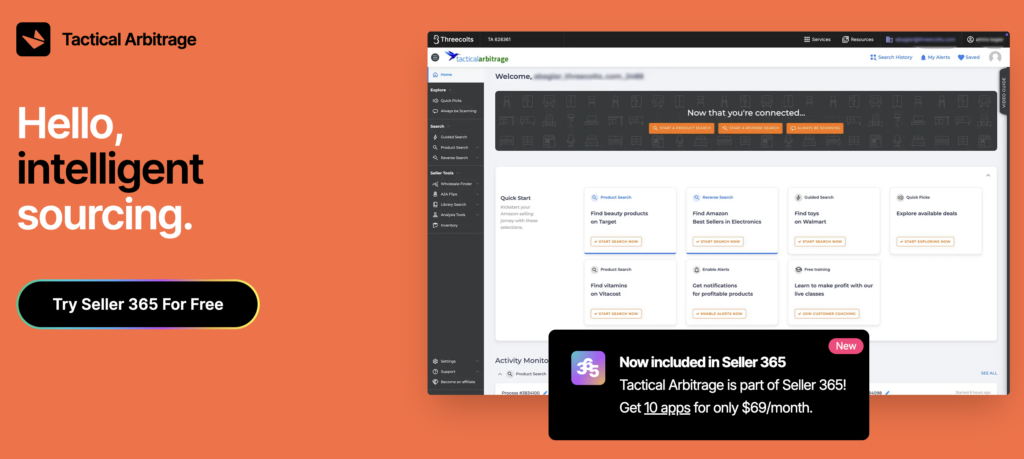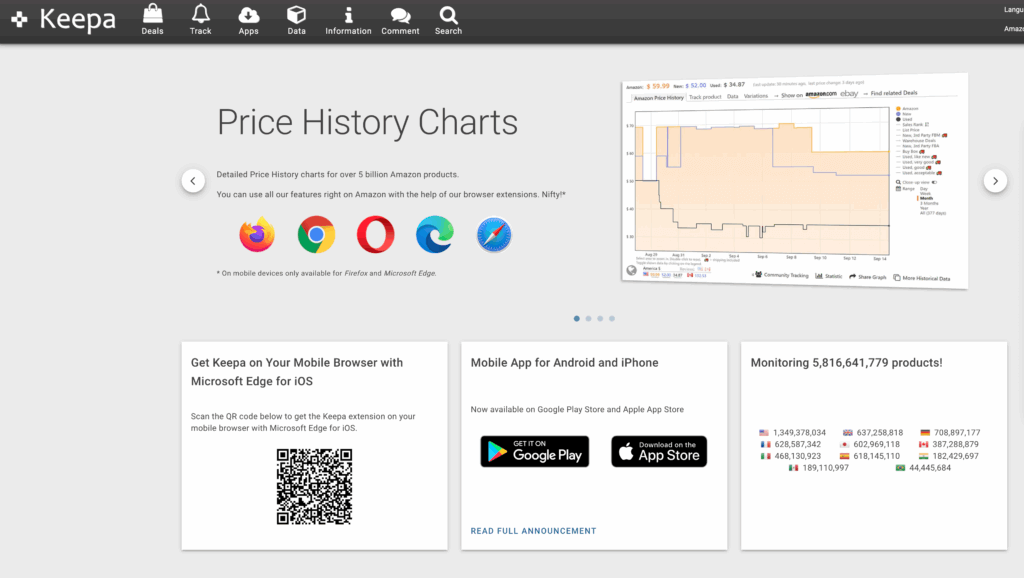- Blog
-
For Sellers
The most popular online arbitrage tools in 2025
When margins get thin, the difference between success and failure often comes down to the toolset you use.

Success in online arbitrage depends entirely on your tool choices. While millions of sellers chase the same overpriced clearance items with outdated software, smart sellers use advanced tools to uncover hidden profits that others miss completely.
Online arbitrage involves buying products from retail websites at low prices and reselling them on Amazon for a profit. This sounds simple until you realize there are millions of products across thousands of websites to analyze. Manual sourcing becomes a nightmare of spreadsheets, calculations, and missed opportunities.
Why do you need tools for online arbitrage?
Checking products manually means visiting hundreds of retailer websites, comparing prices, calculating Amazon fees, and researching sales history. A dedicated person might analyze 50 products per hour and find maybe 2-3 profitable opportunities.
Automated tools scan thousands of products across multiple stores simultaneously. They calculate fees, check restrictions, and flag profitable opportunities instantly. The same person using tools can evaluate 1,000+ products per hour with higher accuracy.
The cost difference is staggering. Manual sourcing requires 40+ hours weekly for a modest income. Tools compress this to 5-10 hours while finding better opportunities.
The most popular online arbitrage tools in 2025
1. Tactical Arbitrage in Seller 365

Tactical Arbitrage dominates online arbitrage because it solves the biggest problem facing sellers: finding profitable products at scale. While competitors offer basic scanning, Tactical Arbitrage scans over 1,500 online stores simultaneously and processes 24 million product matches daily.
For beginners, the platform’s Quick Picks feature shows thousands of pre-analyzed profitable opportunities. Instead of running complex searches, new sellers browse verified deals already checked for restrictions and profitability. This removes the learning curve that stops most beginners.
There’s also a Lite version of Tactical Arbitrage, which has a more minimalist, mobile-friendly interface perfect for those just starting out in the space.
Some other features of Tactical Arbitrage are:
- Wholesale Search: Upload supplier catalogs to instantly analyze entire inventories for profitable opportunities
- Reverse Search: Input ASINs, UPCs, or competitor seller IDs to find sourcing websites for specific products
- Amazon-to-Amazon Flips: Identify price gaps between Amazon marketplaces for cross-border arbitrage
- Library Search: Locate profitable media products (books, CDs, DVDs) from Amazon and specialty sellers
- Always Be Scanning: Hands-free engine that continuously discovers unique leads while you focus on other tasks
But here’s where Tactical Arbitrage becomes unbeatable: it’s included in Seller 365 alongside nine other seller operations tools. Most sellers spend $300+ monthly on separate sourcing, prep, repricing, and analytics tools. Seller 365 provides everything for $69/month.
2. SmartScout
SmartScout takes a different approach by focusing on brand-level intelligence rather than individual product hunting. This tool helps sellers avoid saturated markets by identifying brands with high revenue but low competition.
The platform filters brands by revenue, FBA seller count, Amazon in-stock rate, and dominant seller percentage. This data reveals opportunities others miss. SmartScout shows you brands where Amazon isn’t competing directly, or categories with high traffic but few FBA sellers.
SmartScout features:
- Brand Explorer for competitive analysis
- Subcategory Explorer for market opportunities
- Traffic Graph and AdSpy for trend analysis
- Chrome extension for on-page Amazon data
SmartScout works best for sellers who want to create exclusive product lists rather than compete for the same deals as everyone else.
3. ArbiSource
ArbiSource positions itself as a user-friendly alternative to complex scanning tools. The platform’s signature feature is “The Vault,” providing daily lists of pre-vetted profitable products that require minimal analysis.
This tool appeals to sellers who prefer curated opportunities over running their own searches. The Chrome extension works on any website—Shopify, BigCommerce, or independent retailers—expanding sourcing beyond typical arbitrage sites.
ArbiSource features:
- Daily deal lists in The Vault
- Reverse Amazon flips for competitive analysis
- Universal Chrome extension for any website
- Bulk wholesale list uploads for fast analysis
The 7-day free trial with discount pricing makes ArbiSource attractive for sellers testing online arbitrage without major upfront investment.
4. SourceMogul
SourceMogul targets high-volume sellers who need constant deal flow rather than occasional finds.
The platform’s strength lies in processing enormous inventories quickly. This approach works for sellers who can act fast on large quantities of deals.
However, SourceMogul costs $97/month for sourcing alone. So, the higher price point makes sense only for sellers processing hundreds of products weekly.
5. Keepa

Keepa provides essential price history tracking that every arbitrage seller needs. The free version shows basic price history, but serious sellers need the paid tier for complete sales data.
This tool reveals pricing patterns that indicate profitable opportunities. Products with consistently high prices but occasional deep discounts create arbitrage windows. Keepa’s alerts notify you when target products hit your desired price points.
Keepa integrates with most other arbitrage tools, making it a universal foundation for price analysis. At $19/month for full data access, it’s one of the most cost-effective tools in any seller’s arsenal.
Types of tools for your online arbitrage business
There’s more to online arbitrage than sourcing tools, though. As a business, there are also various areas of operations to consider. Here’s a rundown of some of the tools you’ll encounter in your journey in OA.
First, sourcing engines. They form the foundation of any arbitrage operation. These tools scan retail websites, compare prices to Amazon, and identify profitable opportunities. Tactical Arbitrage, SmartScout, and SourceMogul fall into this category.
Analysis tools help evaluate individual products beyond basic price comparisons. They calculate exact Amazon fees, check selling restrictions, and assess competition levels. Tools like Keepa and various Chrome extensions like ScoutX provide this deeper analysis.
Inventory management tools handle the operational side after sourcing. For example, InventoryLab manages prep, labeling, and FBA shipment creation. These tools prevent costly errors that impact account health.
Repricing tools maintain competitive positioning after products go live. SmartRepricer adjusts prices automatically based on competition and inventory levels. This automation protects profit margins while maximizing sales velocity.
Most successful sellers start with one tool per area, but what if we tell you there’s a way to get all of it and more in one subscription?
Seller 365, like we mentioned earlier, is an all-in-one seller operations bundle. It has 10 apps, each focusing on an area of business for Amazon and Walmart sellers. Instead of paying $69 for sourcing, $49 for inventory management, $97 for repricing, and $29 for profit tracking—totaling $244 monthly—you get everything for $69. The math becomes compelling when you also consider the time saved switching between platforms and the reduced complexity of managing multiple vendor relationships.
How to choose the right tools for your business
Choosing online arbitrage tools requires an honest assessment of your current situation and realistic goals. The flashiest software won’t help if it doesn’t match your actual needs and constraints.
Start with your budget reality.
- Calculate total monthly software costs, not just the headline price of one tool
- Factor in trial periods ending and price increases after introductory rates
- Consider annual vs. monthly billing; many tools offer significant discounts for yearly commitments
- Set a hard spending limit before researching tools to avoid feature creep
Match tools to your time availability
- Part-time sellers need automation features that work without constant monitoring
- Full-time sellers can handle more complex tools that require active management
- Consider learning curves as sophisticated tools may take weeks to master effectively
- Evaluate how much time you can realistically spend on sourcing vs. other business activities
Assess your technical comfort level
- Beginners should prioritize user-friendly interfaces over advanced features
- Tech-savvy users can benefit from tools with extensive customization options
- Consider the quality of customer support and training resources
- Test customer service responsiveness during trial periods
Volume-based decision making
- Low-volume sellers (under 50 products monthly) can use simpler, cheaper tools
- Medium-volume sellers (50-500 products monthly) need batch processing capabilities
- High-volume sellers (500+ products monthly) require enterprise-level automation
- Plan for growth; tools that work on 100 products may break down at 1,000
Integration requirements
- List all current tools you use for accounting, inventory, or other business functions
- Prioritize tools that integrate with your existing workflow
- Consider data export/import capabilities if perfect integration isn’t available
- Factor in the time cost of manual data transfer between disconnected systems
Trial period strategy
- Never commit to annual plans without testing monthly versions first
- Use full trial periods to test peak usage scenarios, not just basic features
- Document specific workflows during trials to compare tools objectively
- Test customer support during trials; you’ll need help when problems arise
Growth trajectory planning
- Choose tools that scale with volume increases without dramatic price jumps
- Consider whether current tools will handle 5x your current product volume
- Evaluate upgrade paths within tool ecosystems vs. switching costs later
- Factor in team expansion needs if you plan to hire virtual assistants or employees
Make money from home with online arbitrage
Online arbitrage can generate legitimate remote income when you approach it systematically. Success requires treating this as a real business with proper systems, not a side hobby you tackle with free browser extensions. This means having the right tools and using them consistently.
The key insight from all this is simple: invest in tools that eliminate busywork so you can focus on finding profitable opportunities. Your time should go toward strategic decisions and business growth, not fighting with spreadsheets or juggling multiple login screens. And choose software that scales with your ambitions.
Ready to stop wasting time on manual sourcing and start finding real profits? Try Tactical Arbitrage in Seller 365 free for up to 14 days.






















